1996 CHEVROLET CAVALIER coolant level
[x] Cancel search: coolant levelPage 220 of 372
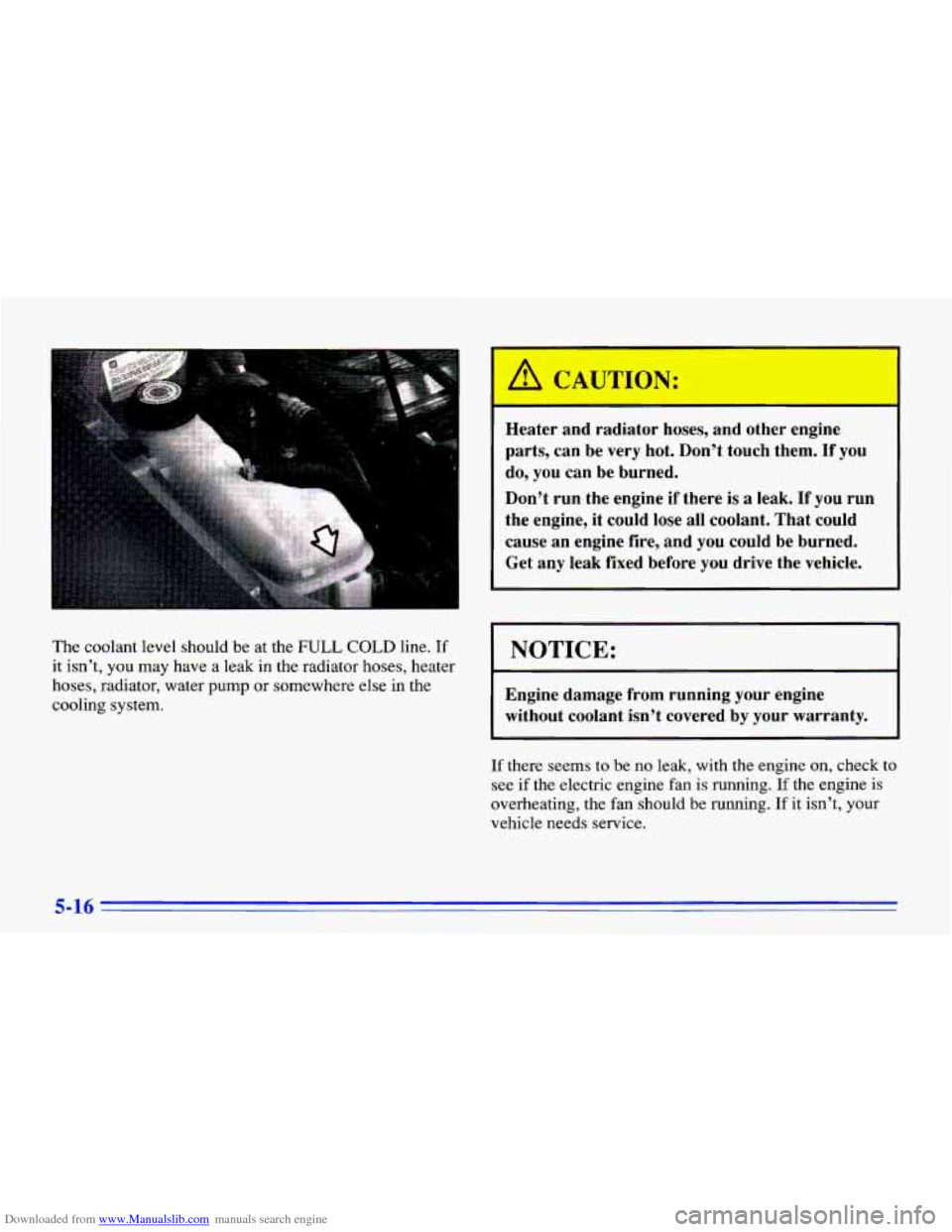
Downloaded from www.Manualslib.com manuals search engine The coolant level should be at the FULL COLD line. If
it isn’t, you may have a leak in the radiator hoses, heater
hoses, radiator, water pump
or somewhere else in the
cooling system.
’ A C * UTION:
-- I
Heater and radiator hoses, and other engine
parts, can be very hot. Don’t touch them. If you
do, you can be burned.
Don’t run the engine
if there is a leak. If you run
the engine, it could lose all coolant. That could
cause an engine fire, and you could be burned.
Get any leak fixed before you drive the vehicle.
I NOTICE:
r
~~ ~
Engine damage from running your engine
without coolant isn’t covered by your warranty.
If there seems to be no leak, with the engine on, check to
see if the electric engine fan is running.
If the engine is
overheating, the fan should be running. If it isn’t, your
vehicle needs service.
Page 221 of 372

Downloaded from www.Manualslib.com manuals search engine How to Add Coolant to the Coolant Surge
Tank
If you haven’t found a problem yet, but the coolant level
isn’t at the
FULL COLD mark, add a 50/50 mixture of
clean water (preferably distilled) and DEX-COOL TM
antifreeze at the coolant surge tank, but be sure the
cooling system, including the coolant surge tank
pressure cap,
is cool before you do it. (See “Engine
Coolant”
in the Index for more information.)
I A CAUTION:
-
Steam and scalding liquids from a hot cooling
system can blow out and burn you badly. They
are under pressure, and if you turn the coolant
surge tank pressure cap
-- even a little -- they
can come out at high speed. Never turn the cap
’ CAUTION: (Continued) when
the cooling system, including the coolant
surge
tank pressure cap, is hot. Wait for the cooling
system and coolant surge tank pressure cap to cool
if you ever have to turn the pressure cap.
5-17
Page 224 of 372

Downloaded from www.Manualslib.com manuals search engine I
4.
I
With the coolant surge tank pressure cap off, start
the engine and let it run until you can feel the upper
radiator hose getting hot. Watch out for the engine fan.
By this time, the coolant level inside the coolant surge
tank may be lower. If the level is lower, add more of the
proper mix
to the coolant surge tank until the level
reaches the
FULL COLD mark.
5. Then replace the
pressure cap. Be sure the
pressure cap is tight.
5-20
Page 260 of 372
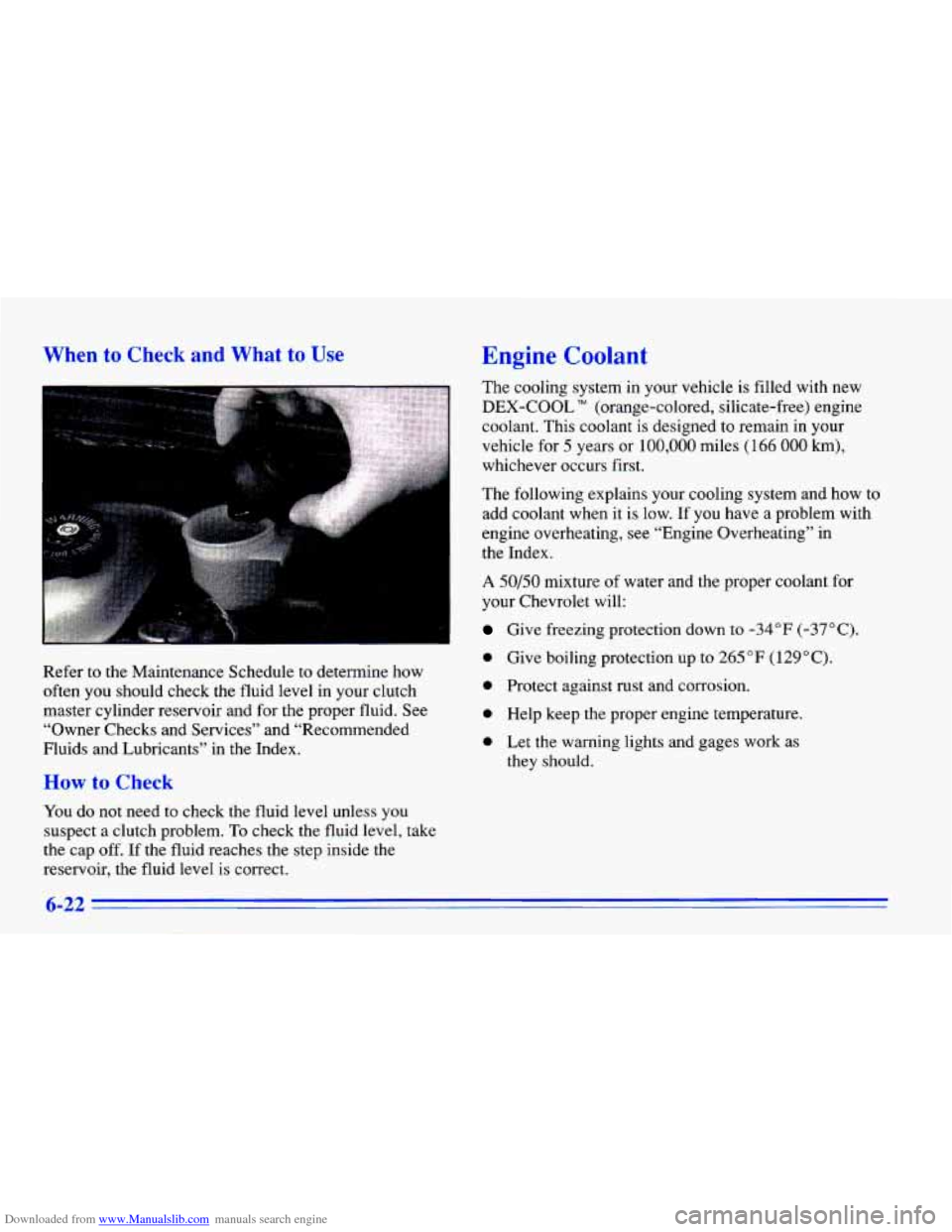
Downloaded from www.Manualslib.com manuals search engine When to Check and What to Use
Refer to the Maintenance Schedule to determine how
often you should check the fluid level in your clutch
master cylinder reservoir and for the proper fluid. See
“Owner Checks and Services” and “Recommended
Fluids and Lubricants” in the Index.
How to Check
You do not need to check the fluid level unless you
suspect a clutch problem. To check the fluid level, take
the cap off.
If the fluid reaches the step inside the
reservoir, the fluid level
is correct.
Engine Coolant
The cooling system in your vehicle is filled with new
DEX-COOL TM (orange-colored, silicate-free) engine
coolant. This coolant is designed to remain in your
vehicle for
5 years or 100,000 miles ( 166 000 km),
whichever occurs first.
The following explains your cooling system and how to
add coolant when it is low. If you have a problem with
engine overheating, see “Engine Overheating” in
the Index.
A 50/50 mixture of water and the proper coolant for
your Chevrolet will:
Give freezing protection down to -34°F (-37OC).
e Give boiling protection up to 265 “F (129°C).
0 Protect against rust and corrosion.
e Help keep the proper engine temperature.
e Let the warning lights and gages work as
they should.
6-22
Page 263 of 372
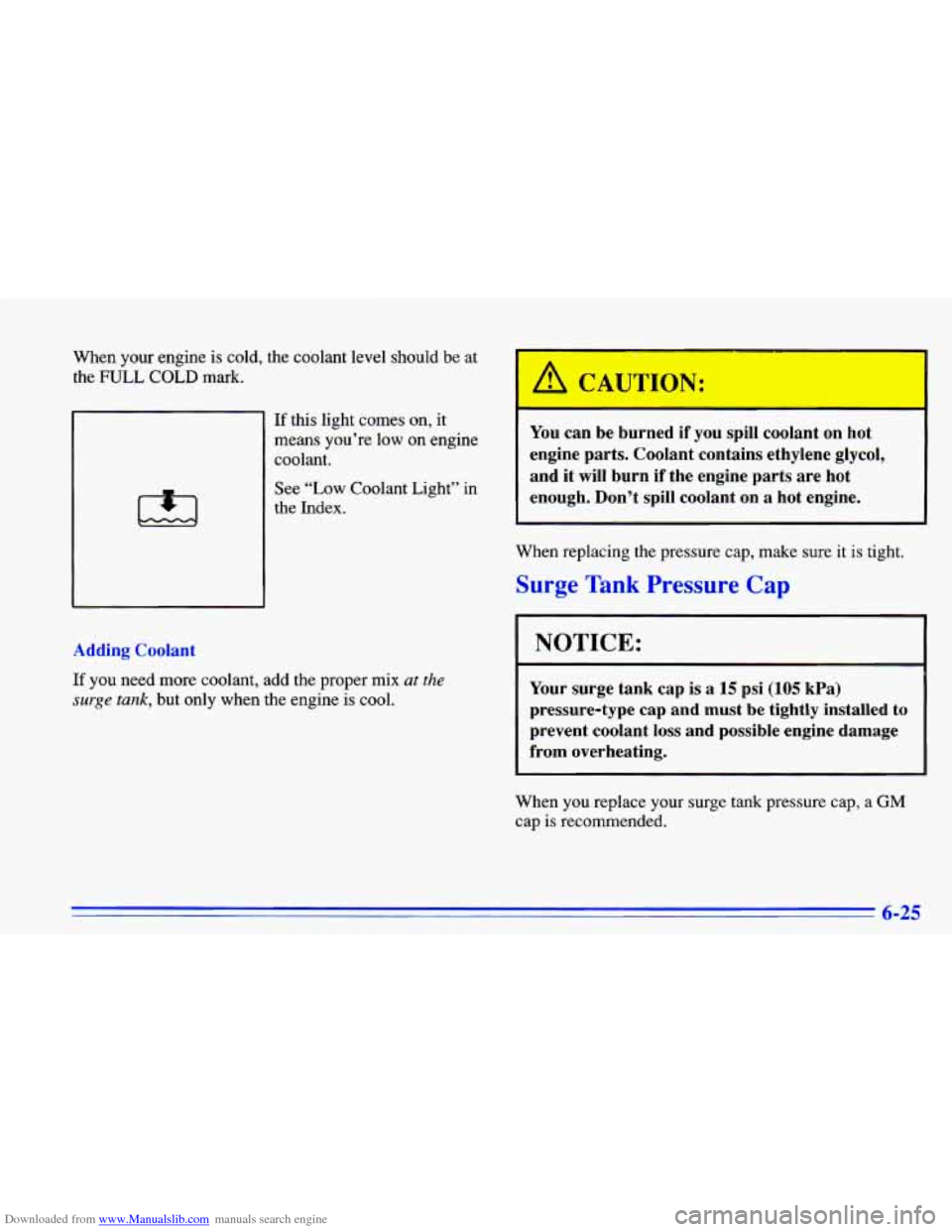
Downloaded from www.Manualslib.com manuals search engine When your engine is cold, the coolant level should be at
the
FULL COLD mark.
If this light comes on, it
means you’re low on engine
coolant.
See “Low Coolant Light” in
the Index.
Adding Coolant
If you need more coolant, add the proper mix at the
surge tank, but only when the engine is cool.
‘ A CAUTION:
You can be burned if you spill coolant on hot
engine parts. Coolant contains ethylene glycol,
and it will burn
if the engine pasts are hot
enough. Don’t spill coolant on
a hot engine.
When replacing the pressure cap, make sure it is tight.
Surge Tank Pressure Cap
Your surge tank cap is a 15 psi (105 kPa)
pressure-type cap and must be tightly installed
to
prevent coolant loss and possible engine damage
from overheating.
When you replace your surge tank pressure cap, a GM
cap is recommended.
6-25
Page 264 of 372
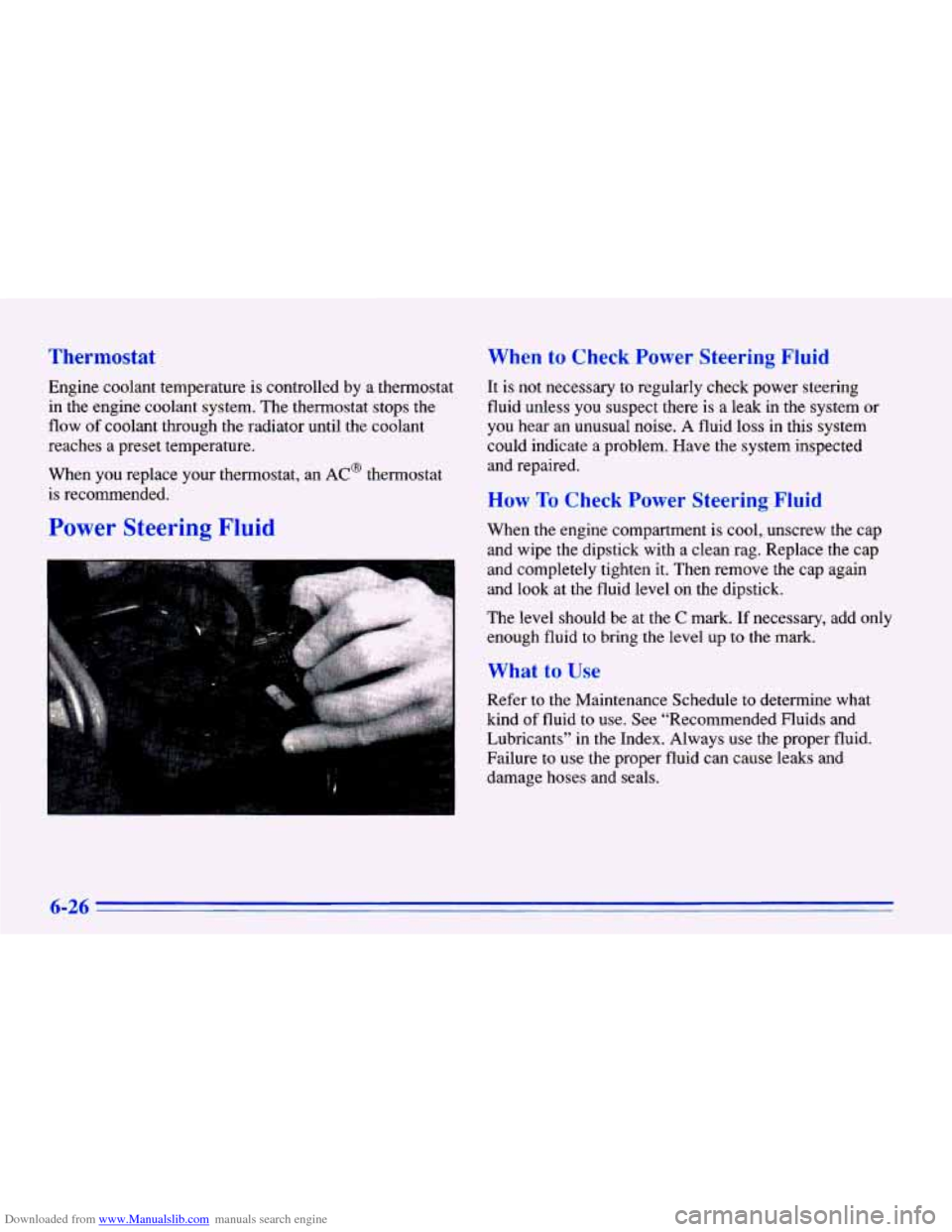
Downloaded from www.Manualslib.com manuals search engine Thermostat
Engine coolant temperature is controlled by a thermostat
in the engine coolant system. The thermostat stops the
flow of coolant through the radiator until the coolant
reaches
a preset temperature.
When you replace your thermostat, an
AC’ thermostat
is recommended.
Power Steering Fluid
When to Check Power Steering Fluid
It is not necessary to regularly check power steering
fluid unless you suspect there
is a leak in the system or
you hear an unusual noise.
A fluid loss in this system
could indicate a problem. Have the system inspected
and repaired.
How To Check Power Steering Fluid
When the engine compartment is cool, unscrew the cap
and wipe the dipstick with a clean rag. Replace the cap
and completely tighten it. Then remove the cap again
and look at the fluid level on the dipstick.
The level should be at the
C mark. If necessary, add only
enough fluid
to bring the level up to the mark.
What to Use
Refer to the Maintenance Schedule to determine what
kind
of fluid to use. See “Recommended Fluids and
Lubricants” in the Index. Always use the proper fluid.
Failure
to use the proper fluid can cause leaks and
damage hoses and seals.
6-26
Page 336 of 372
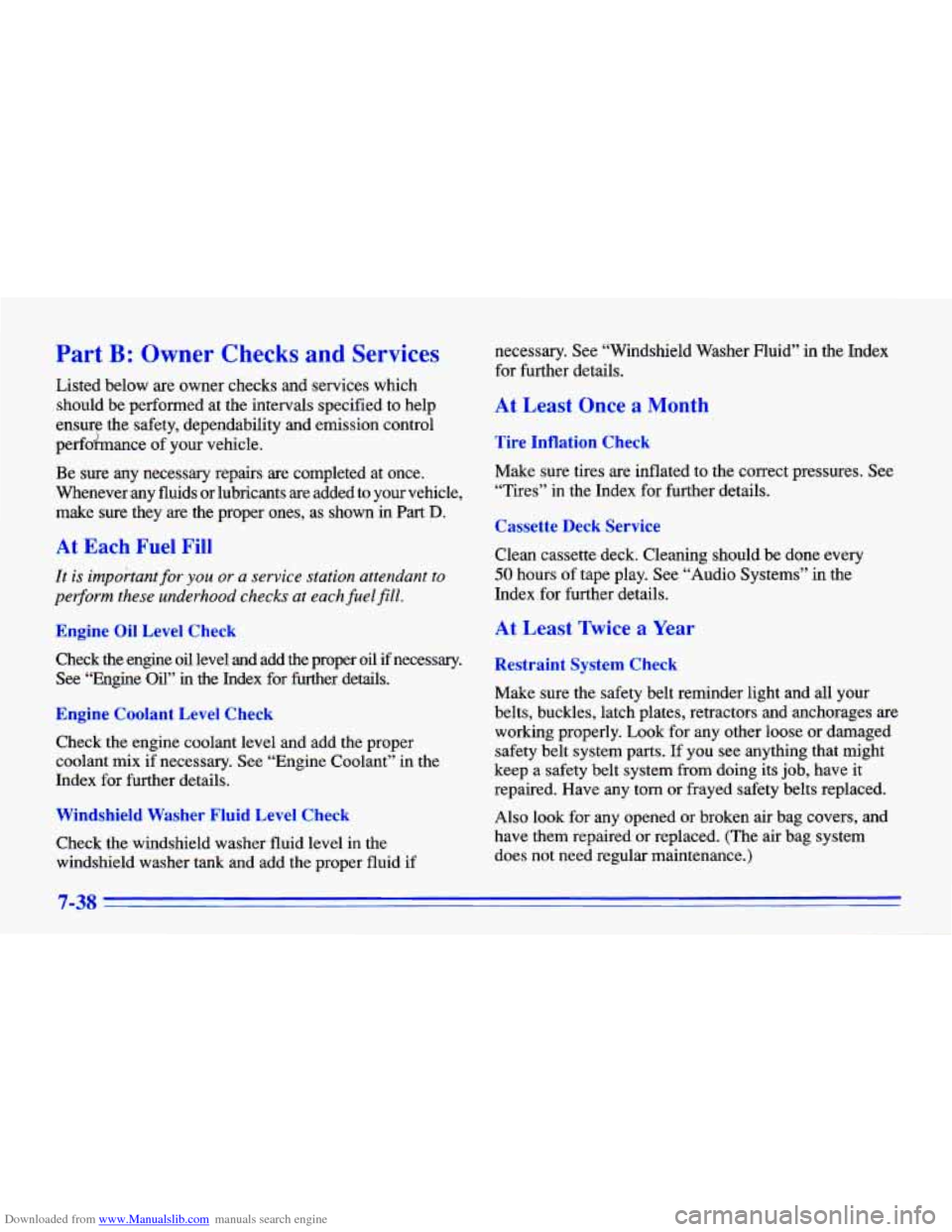
Downloaded from www.Manualslib.com manuals search engine Part B: Owner Checks and Services
Listed below are owner checks and services which
should be performed at the intervals specified to help
ensure the safety, dependability and emission control
perfoJmance of your vehicle.
Be sure any necessary repairs are completed at once.
Whenever any fluids or lubricants are added to your vehicle,
make sure they are the proper ones, as shown in
Part D.
At Each Fuel Fill
It is important for you or a service station attendant to
pe$orrn these underhood checks at each fuel fill.
Engine Oil Level Check
Check the engine oil level and add the proper oil if necessary.
See ‘Engine Oil”
in the Index for further details.
Engine Coolant Level Check
Check the engine coolant level and add the proper
coolant mix if necessary. See “Engine Coolant” in the
Index for further details.
Windshield Washer Fluid Level Check
Check the windshield washer fluid level in the
windshield washer tank and add the proper fluid if necessary.
See “Windshield Washer Fluid” in the Index
for further details.
At Least Once a Month
Tire Inflation Check
Make sure tires are inflated to the correct pressures. See
“Tires” in the Index for further details.
Cassette Deck Service
Clean cassette deck. Cleaning should be done every
50 hours of tape play. See “Audio Systems” in the
Index for further details.
At Least Twice a Year
Restraint System Check
Make sure the safety belt reminder light and all your
belts, buckles, latch plates, retractors and anchorages are
working properly. Look for any other loose or damaged
safety belt system parts.
If you see anything that might
keep a safety belt system from doing its job, have it
repaired. Have any torn or frayed safety belts replaced.
Also look for any opened or broken air bag covers, and
have them repaired or replaced. (The
air bag system
does not need regular maintenance.)
7-38
Page 362 of 372
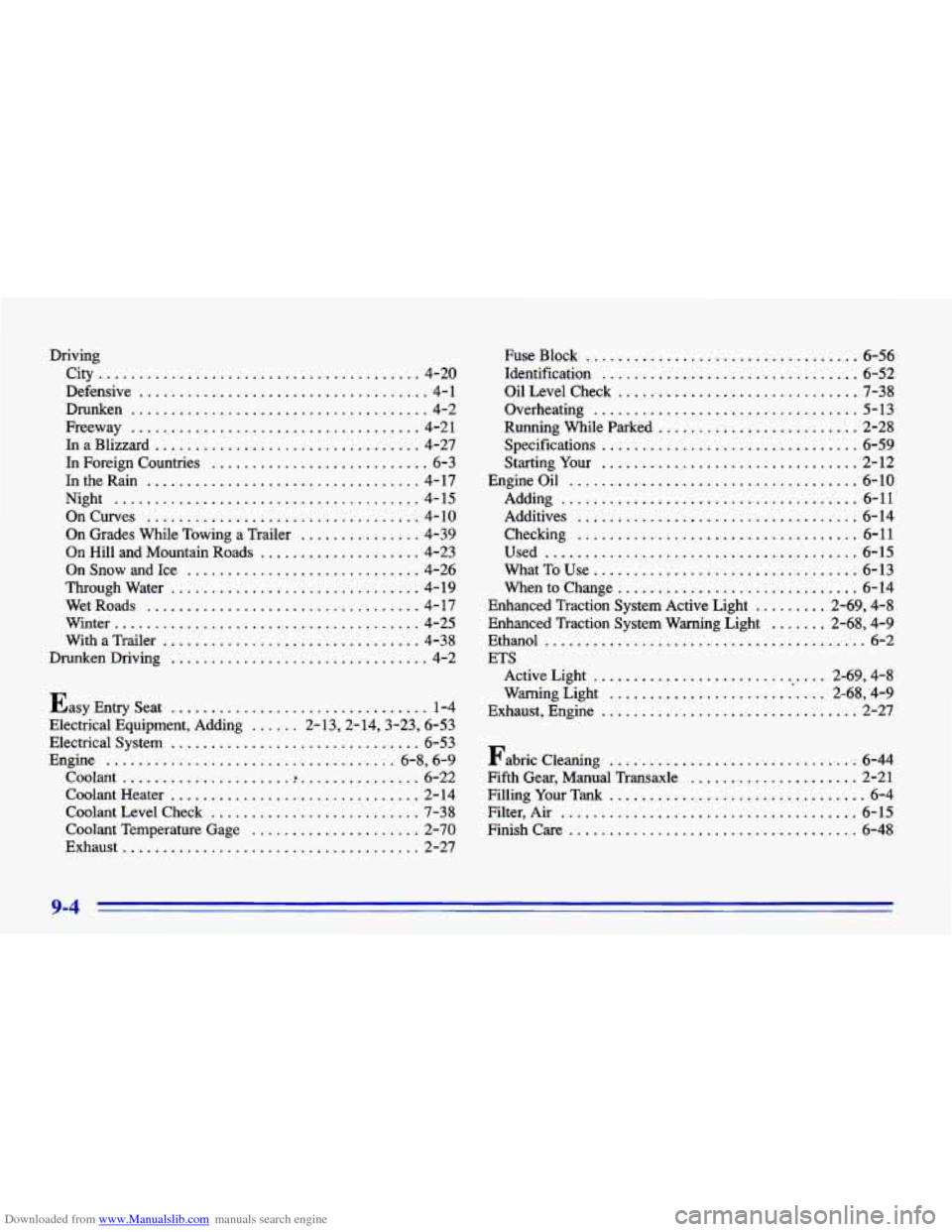
Downloaded from www.Manualslib.com manuals search engine Driving City
........................................ 4-20
Defensive
.................................... 4- 1
Drunken
..................................... 4-2
Freeway
.................................... 4-21
InaBlizzard
................................. 4-27
In Foreign Countries
........................... 6-3
In the Rain .................................. 4-17
Night
...................................... 4-15
OnCurves
.................................. 4-10
On Grades While Towing a Trailer
............... 4-39
On Hill and Mountain Roads
.................... 4-23
On Snow and Ice
............................. 4-26
Throughwater
............................... 4-19
WetRoads
.................................. 4-17
Winter
...................................... 4-25
With a Trailer
................................ 4-38
DrunkenDriving
................................ 4-2
Easy Entry Seat
................................ 1-4
Electrical Equipment. Adding
...... 2.13.2.14.3.23. 6.53
Electrical System
............................... 6-53
Engine
.................................... 6.8. 6.9
Coolant
..................... ! ............... 6-22
Coolant Heater
............................... 2-14
Coolant Level Check
.......................... 7-38
Coolant Temperature Gage ..................... 2-70
Exhaust
..................................... 2-27 Fuse Block
.................................. 6-56
Identification ................................ 6-52
OilLevelCheck
.............................. 7-38
Overheating ................................. 5-13
Running While Parked
......................... 2-28
Specifications
................................ 6-59
Starting Your
................................ 2-12
Engineoil
.................................... 6-10
Adding
..................................... 6-11
Additives ................................... 6-14
Checking
................................... 6-11
Used
............................... .. ....... 6-15
What To Use
................................. 6-13
Whentochange
.............................. 6-14
Enhanced Traction System Active Light
......... 2-69. 4-8
Enhanced Traction System Warning Light
....... 2-68. 4-9
Ethanol
........................................ 6-2
ETS Active Light
............................. 2.69, 4-8
Warning Light
........................... 2.68. 4-9
Exhaust. Engine
................................ 2-27
Fabric Cleaning
............................... 6-44
Fifth Gear. Manual Transaxle
..................... 2-21
FillingYourTank
................................ 6-4
Filter. Air
..................................... 6-15
Finish Care
.................................... 6-48